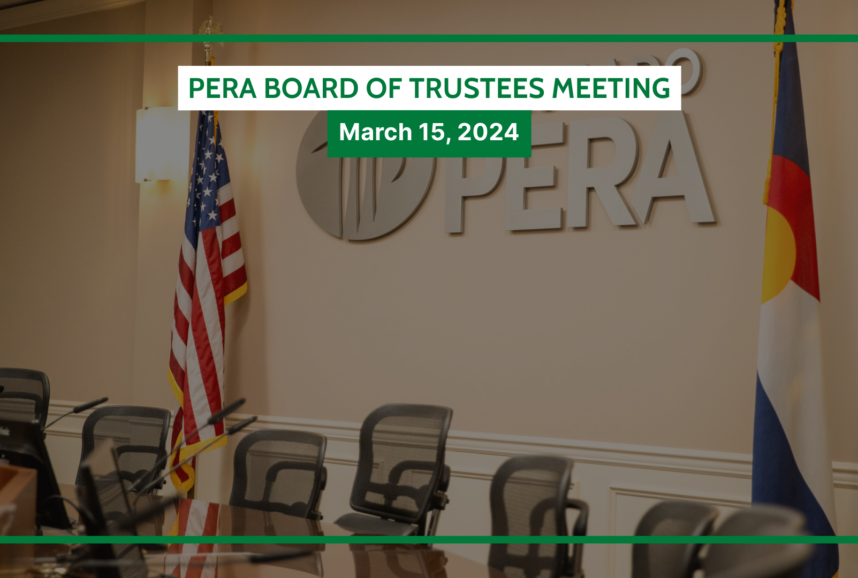How should PERA invest the roughly $50 billion PERA portfolio?
That question was answered on November 15, when PERA’s Board of Trustees approved updated asset allocation guidelines. asset allocation is the term used to describe how the total amount of dollars invested are divided among various investment types, also known as asset classes.
The Board does not make individual investment decisions—PERA’s investment team fulfills that role. Instead, the Board sets the course for PERA’s investment strategy, broadly speaking. This is not a one-time decision. The Board usually reviews and approves asset allocation needs every three to five years.
The Board first sought a thorough review of its options. In particular, they weighed how different proposed options would contribute to the overall goal of becoming fully funded in 30 years. They considered risk, return, and the cost of managing investments, among other factors.
The Board worked with Aon, an outside firm, on this project. Aon compiled a report that included multiple options for the Board to consider. (Read prior reporting on this process here. The full report can be viewed in full here.)
The Board sets two important guidelines for each asset class. The first is a long-term target, which is defined by a specific percentage. The second is a target range, which includes a minimum and maximum percentage.
The target range gives the investment team increased flexibility. For example, if one asset class.s performing better than expected relative to other asset classes. it might grow beyond the long-term target. The target range’s higher ceiling allows that asset class.o continue to grow without unnecessarily selling assets, which incurs additional costs.
| PERA’s asset allocation, as approved by the Board Effective 1/1/2020 |
||
| Long-Term Target | Target Range | |
| Global Equities | 54% | 48%-60% |
| Fixed Income | 23% | 18%-28% |
| Private Equity | 8.5% | 4%-13% |
| Real Estate | 8.5% | 4%-13% |
| Alternatives* | 6% | 0%-12% |
| Cash | 0% | 0%-3% |
*Note: The
asset class.urrently named Opportunity Fund was renamed Alternatives,
effective 1/1/2020.
Choosing an asset allocation is a decision that individuals and institutional investors alike must make. But this comparison has limits. Individuals investing for their own retirement have a closed time frame. They need income in retirement, but that need ends upon death. PERA, on the other hand, operates in an open-ended environment. It needs to last in perpetuity. When the Board sets the asset allocation, they seek to maximize long-term returns, meeting the retirement security needs of all 600,000 Colorado PERA members
For more information about PERA’s investment strategy and performance history, visit the investments page of copera.org or watch the video below.
Asset classesA category of similar investments. Common asset classes include global equity (such as publicly traded stocks), real estate, and cash.Asset classesA category of similar investments. Common asset classes include global equity (such as publicly traded stocks), real estate, and cash.AlternativesA broad category of investments that don’t fit into traditional categories like stocks and bonds.Asset allocationAn investor’s mix of stocks, bonds, and other investments. PERA’s strategic asset allocation is set by the PERA Board of Trustees.Asset allocationAn investor’s mix of stocks, bonds, and other investments. PERA’s strategic asset allocation is set by the PERA Board of Trustees.Private equityA type of investment in which investors purchase shares of a company that is not traded on a public stock exchange.Fixed incomeA type of investment that pays investors a fixed rate of interest over a set period of time. Bonds are a common type of fixed income investment.Asset classA category of similar investments. Common asset classes include global equity (such as publicly traded stocks), real estate, and cash.Asset classA category of similar investments. Common asset classes include global equity (such as publicly traded stocks), real estate, and cash.Asset classA category of similar investments. Common asset classes include global equity (such as publicly traded stocks), real estate, and cash.Asset classA category of similar investments. Common asset classes include global equity (such as publicly traded stocks), real estate, and cash.





Not sure what the benefits are but see annual costs between $50 million and $80 million and one time costs between $16 million and $46 million with small improvement in return. Between frozen COLA’s and increased health care premiums this proposal is obscene. Time to reduce costs of private equity investment not increase!
Thanks for your comment, Dave. I believe you are referencing figures from the three sample portfolios found in the Aon report? During the Board meeting, PERA investment staff noted those additional costs weighed against the benefits as one factor to consider. While the Board used the report’s research and analysis during their deliberations, they did not end up adopting any of those three sample portfolios. They chose a different route. The asset allocation the Board approved keeps private equity target closer to its current level.
First of all, I really appreciate and admire that PERA is staffed with people who value what they do and do it well. I am blessed to be a PERA retiree in this day and age. I couple of thoughts:
I think the handwriting is on the wall both scientifically and a swelling political tide: for you all to consider increasing our investments into those industries which encourage and pursue addressing climate change, even at the expense of maximizing profits. I suspect that those experts at PERA could accomplish both. This is no longer a matter or opinion: you know that and so do a huge majority of your constituency. You have always tried to do the right thing. I think the majority of we who are impacted would applaud you. It is one way we too can make a difference.
Secondly. I have long felt that addressing social security by those who can and should, has been kicked down the road far too long, for all the wrong reasons. The fact it is this is a task which impacts each of us, including those who are not beneficiaries and our grandchildren who have not been born. I think PERA could show the way: If every one of us sacrificed just a bit, with those who have the least amount of time doing the least and those who are progressively younger doing a bit more, we could extend PERA benefits even further. The “greatest generation” recipients could forego a portion of their COLA. The “baby boomers could forego even more of the COLA. Those who have yet to retire could see an additional mandatory retirement age be added on to achieve full benefit , say, “one month for every year they have left to retire”. This would allow those who have the most years until retirement the most time to plan for this. (Or some other metric.)
We have belonged to an organization of employees who have served the public. I think this might resonate again as the right thing to do with those servants.
There are many reasons not to do any of this: “We’ve given all our working lives. We can’t keep up as it is already. Why should we have to give when other do not? \”
But then again….why not?
But most of…again…thank you.